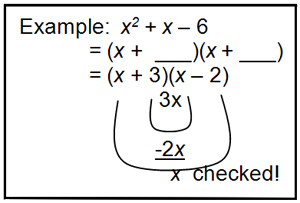Rule #4
If a polynomial has three terms and the leading coefficient is 1, then factor and check.
x2 + bx + c
(x + ___)(x + ___)
Remember to put x's.
Find factors of c that add up to b.

The fourth rule to factoring is to look for polynomials with three terms. If the leading coefficient is 1, you factor the last term and find the two factors that add or subtract to make the middle term like Rule #4.
Rule #5 states that if the leading coefficient is not 1, you factor both the first and last terms and find the two products that add or subtract to make the middle term.
Rule #4If a polynomial has three terms and the leading coefficient is 1, then factor and check. x2 + bx + c |

|
Rule #5If a polynomials has three terms and leading coefficient is NOT 1, then multiply a • c, find factor and check with smiley. ax2 + bx + c |

|
Do you need more help factoring? Click the link below, which will let you practice factoring problems like Rule #5.
Instructions: Type in the factors, and click "Submit".